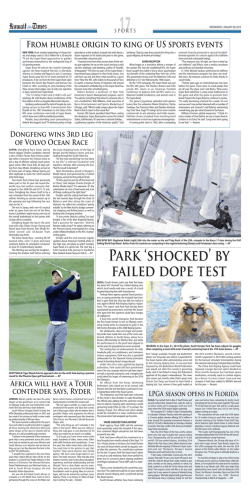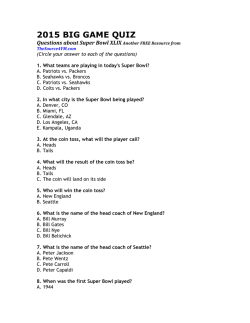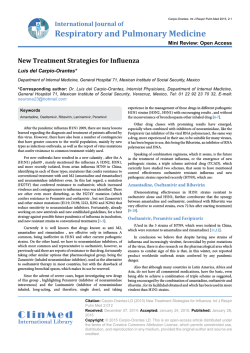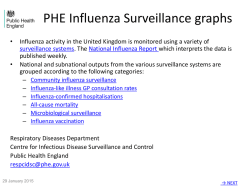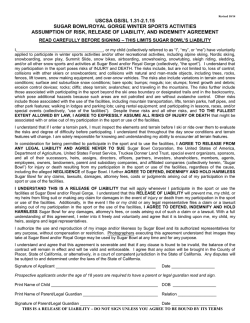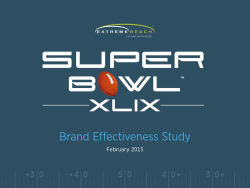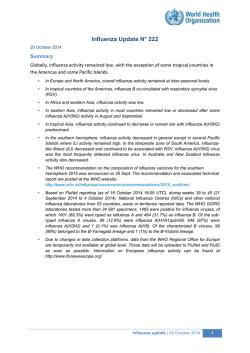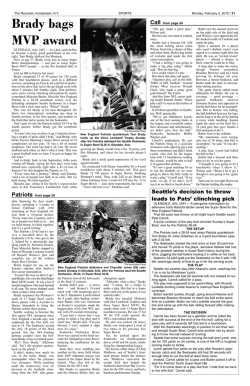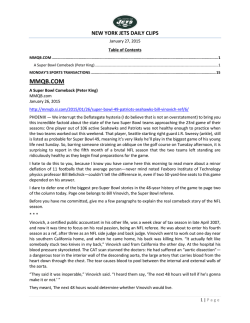
Success is Something to Sneeze at: Influenza Mortality in Regions
Tulane Economics Working Paper Series Success is Something to Sneeze at: Influenza Mortality in Regions that Send Teams to the Super Bowl Charles Stoecker Department of Health Management and Policy Tulane University School of Public Health and Tropical Medicine New Orleans, LA [email protected] Nicholas J. Sanders Department of Economics College of William & Mary Williamsburg, VA [email protected] Alan Barreca Department of Economics Tulane University New Orleans, LA [email protected] Working Paper 1501 January 2015 Abstract Using county-level Vital Statistics of the United States data from 1974-2009, we employ a differencesin-differences framework comparing influenza mortality rates in Super Bowl-participating counties to non-participants. Having a local team in the Super Bowl causes an 18% increase in influenza deaths for the population over age 65, with evidence suggesting one mechanism is increased local socialization. Effects are most pronounced in years when the dominant influenza strain is more virulent, or when the Super Bowl occurs closer to the peak of influenza season. Mitigating influenza transmission at gatherings related to large spectator events could have substantial returns for public health. Keywords: influenza, externality, Super Bowl JEL: I18, L83, R53 1 Introduction Governments dedicate substantial public health resources to containment of influenza pandemics. For example, the federal government spent $3 billion in direct response to the 2009 H1N1 pandemic (Centers for Disease Control and Prevention unpublished data). Uncontained epidemics can be costly in terms of loss of life: the 1918–1919 and 1957–1959 pandemics caused an estimated 500,000 and 86,000 excess deaths, respectively, in the United States (Crosby, 2003). The Centers for Disease Control and Prevention (CDC) estimates a pandemic of similar magnitude to that in 1957 would cost the United States $71 billion today, even before including disruptions to commerce and society (Meltzer et al., 1999). A more recent estimate puts the cost of the 2009 H1N1 pandemic at $65 billion including all societal costs (Lee et al., 2010). Investments made ex ante that minimize risk are efficient given such large ex post containment costs. Vaccination represents the most effective preventive strategy, but is often unavailable in the short term due to production constraints (Hinman et al., 2006; Sloan et al., 2004). Changes in mixing patterns (the degree and manner of physical interaction among individuals) may provide an alternate short-term shift in transmission rates. To test for such effects, we use annual and geographic variation in local sports team success as a proxy for changes in mixing rates through increased fan travel or local gatherings. We find increased mixing, as proxied by team success, increases local influenza mortality, suggesting small-scale mixing plays an important role. Counties in MSAs with teams participating in championship play see an increase in influenza deaths of approximately 18%, with larger effects when the game occurs closer to the peak of influenza season, or when the dominant influenza strain is more lethal. Influenza is an infectious disease that spreads by airborne droplets with an approximate travel radius of 6 feet, making close human contact an important infection vector (Centers for Disease Control and Prevention, 2012). Strategies for transmission reduction may include altering human mixing rates and limited contact with “vulnerable” populations such as the elderly or very young, 1 but there is limited empirical evidence changes in mixing and contact have an economically meaningful impact on influenza incidence. Recent studies rely on plausibly exogenous events as natural experiments that alter contact or travel rates. For example, Brownstein et al. (2006) examined how the decline in air travel after September 11th, 2001 affected the seasonal influenza peak, and found a 27% reduction in air travel postponed the peak by 13 days.1 Cauchemez et al. (2008) examines the impact of holiday school closures in France on influenza transmission in children. Research detected heightened influenza infection rates at the 2002 Winter Olympics (Gundlapalli et al., 2006), the 2006 World Cup (Schenkel et al., 2006), music festivals (Botelho-Nevers et al., 2010; Guti´errez et al., 2009), and the yearly Hajj pilgrimage to Mecca (Balkhy et al., 2004). Such studies are informative, but focus only on a single instance of each event, thus lacking explicit control groups. We examine influenza transmission with a repeated event and explicit treatment and control groups by looking at how local sports team success, here participation in the playoffs and championship game of the National Football League (NFL), impacts influenza mortality in the United States. The Super Bowl and associated playoff ramp-up take place every year in January and February, traditionally high influenza periods, providing over thirty years of similar events as a basis for our study. If the local population increases mixing as a result of team success, e.g., through private gatherings or attending sports bars to watch games, team success provides a proxy for shifts in socializing behavior during periods of traditionally higher influenza transmission. Using mortality data from restricted Multiple Causes of Death data covering 1974-2009, we calculate percent changes in reported influenza deaths, with a focus on mortality for those over the age of 65, historically the most vulnerable population (Thompson et al., 2003). Though populations over 65 may not change behavior in response to team success, their chances of contact with an infected individual increases as the infection rate increases in the population overall. 2 Our core estimation 1 This result may be particular to 2001 and has not been borne out by correlations in thirty other years of data (Viboud et al., 2006). 2 Vaccinating health care workers is a demonstrated strategy for reducing influenza mortality in the elderly (Potter 2 strategy employs a differences-in-differences framework to compare areas with successful football teams in a given year, as measured by qualifying playoffs and the Super Bowl, to areas that also house football teams but that, in that year, did not successfully reach postseason play. There are several advantages to using team Super Bowl attendance as a proxy for increased travel and gatherings. First, the championship game itself is a very large gathering; in recent years, attendance has crested 100,000. Second, the postseason often takes place during the height of influenza season (influenza morbidity and mortality generally peaks between December and March in the United States (Doshi, 2008)) making related travel and gatherings more relevant for our disease of interest. Third, cities with NFL teams that did not qualify for postseason play make an ideal control group, as they are relatively similar in size, wealth, and influenza mortality patterns to those that attend. This is particularly true in professional football, where revenue sharing and salary cap policies reduce the formation of legacy teams that annually attend the Super Bowl; Figure 2 shows that for the 36 championship games between 1974 and 2009, 25 of the 31 NFL cities had a team qualify at least once. Fourth, the location of postseason play changes from year to year. For playoff games, relative team records determine the hosting city. Super Bowl games occur in pre-determined cities, some of which are frequent hosts — Figure 1 shows that all 36 seasons we consider culminate in the same 11 host cities. We hypothesize three plausible mechanisms through which a local team qualifying for postseason play could impact influenza transmission. First, an increase in large gatherings increases the frequency of human contact and probability of transmission. Here, postseason play can increase gatherings both in the host area (through the playoff or championship game itself) and in the areas with successful teams (through increased attendance at home sports parties, sports bars, etc.). Second, postseason play alters travel patterns and increases the contact or mixing rate between possible susceptible and infected groups via fan mobility, increasing opportunities for exchange as well as et al., 1997) which shows a potential transmission path from more sports-social age groups to potentially less enthusiastic older populations. Further, while daily contacts are generally with individuals of similar ages, this assortative mixing within age groups is least pronounced for those age 65 and older (Mossong et al., 2008). 3 co-infection. Third, postseason play may affect local economies in areas with participating teams, through increased tourism from outside or increased local expenditures. Changes in local income or employment rates may in turn influence behavior and health expenditures.3 Without specific data on travel and gatherings, we are unable to explicitly separate the three potential mechanisms. However, we consider both (1) mortality in areas that host the Super Bowl and (2) mortality in areas that send a team to the Super Bowl. Using annual variation in influenza mortality risk across both sending and hosting areas, we find strong evidence in favor of local gathering transmission with little evidence of travel or economic effects: hosting the Super Bowl does little to change host-MSA mortality risk, and sending-team MSA outcomes correlate more with local risk rates than hosting-MSA risk rates.4 We find non-zero effects for teams in playoff games as well, which suggests some effect comes from general team success and supports the mechanism of increased local gatherings. We contribute a unique perspective to the literature on benefits of both promoting local sports teams as a source of economic development and hosting large-scale sports events as a source of tourism. As of yet, no other studies examine the potential disease costs imposed on local residents from having a successful sports team. As is expected, we find no comparable impacts for other, non-communicable diseases, or for influenza transmission one or two years before or after the successful year. 2 Estimation Strategy We employ a differences-in-differences model, where the unit of observation is the county-season, to identify the role of team success on local health. In a given season, treated counties are those that 3 Hosting a championship game moves workers from other sectors of the economy into the Amusements and Recreation sector (Coates and Humphreys, 2003), altering local business patterns and large-scale interaction. 4 Controversy about the true size of the economic impact of being championship game host city has proliferated in the popular press (Matheson and Baade, 2006; Bialik, 2010; Rishe, 2012), and increased influenza transmission presents another potential externality of being a host city. 4 reside within a Metropolitan Statistical Area (MSA) housing an NFL team that made it to the Super Bowl. Control counties are those in MSAs housing less successful, non-Bowl NFL teams. Though treatment and control status is common across counties within an MSA, we conduct our analysis at the county level to more precisely control for time-varying local conditions. Specifically, we estimate: M ortc,t = α + βAttendc,t + δXc,t + λc + γt + c,t (1) where M ortc,t is the influenza mortality rate in county c at season t; Attendc,t is a dummy variable equal to one when the team in the MSA including county c makes it to the Super Bowl; and Xc,t is a collection of county specific controls at time t. To control for demographic changes that may make a county more susceptible on average to influenza mortality (Quinn et al., 2011) we control for percent of the population that is nonwhite. While the majority of our regressions explore death rates in the population age 65 and over, we also control directly for the percent of the population age 65 and older to account for potential changes in contact patterns within counties. To account for fluctuations in influenza transmission due to environmental factors (Soebiyanto et al., 2010), which could be potentially correlated with local team success through home field effects or more productive practice sessions we include flexible time-varying environmental controls. We control for average number of days in bins of 10 degrees Fahrenheit with categories for less than or equal to 30 degrees or greater than 90 degrees, average number of days with humidity in 2 g/kg (grams of water vapor per kilograms of air) bins with a category for greater than 18 g/kg, and precipitation in 50 inch bins with a category for greater than 100 inches of precipitation. The coefficients λ and γ are county and season of influenza fixed effects to account for different background levels of disease activity in each place or season. In expanded models, we include county-specific linear or quadratic time trends to allow for correlation between changing health outcomes and the likelihood of sending a team to the Super Bowl over time (though as noted 5 above, profit-sharing among NFL teams reduces correlation in team success across time). The coefficient β shows the reduced form marginal effect of sending a team to the Super Bowl on influenza mortality (relative to other counties in MSAs that house NFL teams). In models checking for local hosting effects, we classify treatment as being in the same MSA as the host stadium of the Super Bowl. We weight all regressions by population of the indicated age cell, and cluster standard errors at the MSA level to account for geographically-common relationships between local sports team success and influenza mortality. 3 Data We combine data on death records, population, and weather with dates and locations of Super Bowls between 1974 and 2009.5 The number and location of deaths come from restricted use Multiple Cause of Death Files from the National Center for Health Statistics Vital Statistics System.6 We generate the denominator for death rates using population data from the Surveillance, Epidemiology, and End Results (SEER) Program from the National Cancer Institute. We use the countylevel file with data on population by race and single-year age group. We collapse all estimates to the county by relevant age group indicated in the tables. To match population denominators, we assign deaths by county of residence rather than county of occurrence.7 The Multiple Cause of Death File data shows cause of death according to International Classification of Disease (ICD) Codes that appear on the death certificate. We code deaths as due to influenza if any of the influenza codes appear on the death certificate. This means we incorrectly 5 We omit the 1972–73 flu season due to a disproportionately high mortality in California that year, which also served as the hosting state for that year’s Super Bowl (Chin et al., 1974). Results including 1972–1973 show unrealistically large effects of being a hosting county that persist in no other year. 6 Starting in 1989 county of residence for small counties and date of death are only available in the restricted use file: tabulations of MSA level mortality rates (as well as compilations of Super Bowl and playoff hosts, participants, and dates) are available upon request. 7 County of occurrence may correlate with the Super Bowl for reasons other than disease transmission caused by the event. A decedent that traveled to a county associated with a successful NFL team may contribute to the number of influenza deaths in that county, but he may have died regardless. 6 classify deaths due to influenza but marked as another cause, causing measurement error in our outcome of interest. In effect, we explore the relationship between sending a team to the Super Bowl and observed influenza mortality rather than the total number of influenza deaths. Assuming any such error is classical and uncorrelated with unobservables, it will attenuate estimated effects of Super Bowl attendance and increase standard errors. Our controls and fixed effects aim to capture and remove further differences in levels or trends of disease classification that vary across counties or over time in a manner unrelated to the Super Bowl. As our period of interest spans three ICD editions (8, 9, and 10), we follow published comparability classifications (Klebba and Scott, 1980; Anderson et al., 2001) to maintain consistency across systems.8 In some estimates we stratify our model by dominant influenza subtype using previously published data for seasons from 1974-1999 (Greene et al., 2006) and from Influenza Season Summaries provided by the Centers for Disease Control and Prevention for seasons after 1999 (Centers for Disease Control and Prevention, 2014). To control for weather effects, we obtain county-level humidity measurements from the Global Historical Climatology Network and temperature and precipitation measures from the Global Summary of the Day. The National Oceanic and Atmospheric Administration National Climatic Data Center maintains both data sets. Table 1 shows means of outcome and control variables for various levels of involvement with the Super Bowl. We limit analysis to counties within an MSA with an NFL team. To obtain a balanced panel, we include all counties that ever had a NFL team during our sample period, even if the NFL removed or added the team at a later date: this includes Los Angeles (which had a team until 1994) and several expansion cities, most recently Nashville, which acquired a team in 1998. The resulting 278 counties span 30 states and cover approximately 50% of the United States population. We also explore panels limited to cities with teams that ever attended the Super Bowl or cities that had an NFL team throughout the sample period. 8 Influenza deaths are codes 470-474 in the Eighth Revision, 487 in the Ninth Revision, and J10-J11 in the Tenth Revision. 7 4 Results We use our core differences-in-differences identification strategy (Equation 1) throughout. We first examine the impact of hosting the Super Bowl in Table 2. Being a host city is theoretically orthogonal to local team success, as the NFL determines Super Bowl location prior to the beginning of the relevant season. We find point estimates are negative but sufficiently noisy that we are unable to reject either negative or positive effects. We take this as suggestive evidence that Super Bowlrelated travel does not pose a significant transmission risk for hosting cities. A number of effects might explain the negative coefficient: host cities may see an influx of income, raising health and health behavior, local mixing within hosting cities may not increase as a consequence of the Super Bowl game, or locals may actually decrease mixing in response to increased travelers (avoiding traffic, busy restaurants, etc.). These results suggest there is no net negative health effect of hosting a Super Bowl. We next address the role of local team success, as measured by a local team attending the Super Bowl. Table 3 presents our findings. Panel A displays results across all ages and Panel B limits the sample to those age 65 and over. We find a local team making it to the Super Bowl increases influenza mortality in the participating county. The coefficient on Attend shows sending a team to the Super Bowl has a statistically significant effect for both all-age mortality and mortality among those age 65 and over. Focusing on the elderly, Panel B indicates sending a team to the Super Bowl leads to an additional 7 reported influenza deaths per million for those aged 65 and older in the home county. This is an 18 percent increase over the observed average (40.7 reported influenza deaths per million population age 65 and over). Point estimates are similar after adding countyspecific linear (Column 2) and quadratic (Column 3) time trends. Column 4 limits the sample to counties with teams that ever attended the Bowl, which eliminates some counties associated with historically less-successful teams and newer expansion teams. In the more restricted sample our estimated impact is similar in precision and magnitude to that in the full sample. In all specifica- 8 tions other than Column 2 of Panel B, results are statistically different from zero at a minimum of 5%, and statistically different from zero at a minimum of 10% in all specifications. Table 4 restricts the sample to influenza seasons where we are either more or less likely to detect an effect. Column 1 breaks the sample into seasons where the Super Bowl occurred within 24 days of the period of highest annual influenza mortality nationwide.9 Column 2 limits the sample to seasons where the Super Bowl occurred 24 or more days away from the seasonal influenza mortality peak. In seasons where the Super Bowl was closer to the peak, mortality effects are over seven times larger (29% impact vs. 4% impact). We next limit the sample to years where the dominant influenza subtype was especially virulent (Column 3) or especially mild (Column 4). The percent effect of attending the Super Bowl on influenza mortality during seasons dominated by the more virulent A(H3N2) or A(H2N2) viruses (Greene et al., 2006) is approximately twice as large as the impact of attending the Super Bowl in a year where the dominant subtype are the less virulent A(H1N1) or B viruses (Greene et al., 2006). Taken as a whole, the results in Table 4 support influenza as the vector of increased mortality. We next consider how effects vary by expected baseline risk and ICD classification. Columns 1 and 2 of Table 5 stratify by season-specific influenza risk. For each season, we calculate the all-age influenza death rate in the hosting MSA and average all-age death rate across both attending MSAs. Column 1 limits the sample to seasons when the population-weighted average influenza risk among all MSAs sending teams was in the top half of all rates. Column 2 limits the sample to years when the influenza death risk for MSAs hosting the game was in the top half of all rates. Team-sending cities experiencing contemporaneously high influenza mortality may be more likely to (1) pass influenza to other travelers at the Super Bowl game and (2) pass influenza locally at increased gatherings. The point estimate for influenza mortality in team-sending cities is slightly higher (23% versus 18%) during seasons when team-sending cities experience heightened mortality. Column 2 9 We measure the peak of influenza mortality using the midpoint of the seven-day period with the highest influenza season mortality rate. We use 24 days as it comes closest to splitting our sample in half. 9 repeats this stratification for the hosting MSA. When hosting cities experience heightened influenza mortality, conditions may be more amenable to transmission of influenza from locals to travelers, and travelers may be more likely to return to their home cities infected. We find when cities above the median reported annual influenza mortality rate host the Super Bowl, the relationship between sending a Super Bowl team and local influenza mortality is effectively unchanged for sending cities than in the unrestricted sample (19% versus 18%). The effect of sending a team to the Super Bowl is affected more by unusually high mortality rates in the area that sends the team rather than in the area the hosts the game. Since our analysis spans several ICD schemes, Columns 3, 4, and 5 of Table 5 restrict the sample to each regime, respectively. Results are consistent with previous estimates but imprecisely estimated. Point estimates are all positive and we cannot rule out impacts the same size as our main effect in each regime. In the restricted sample we cannot rule out the null hypothesis of no impact at conventional confidence levels.10 In stratifying by ICD regimes, we allow all included covariates to have differential effects by regime as well. The reader should keep this in mind when attempting comparison of effects across periods and with the full-sample estimate. Thus far, our model bundles the impact of several aspects of successful team performance into a single estimate of sending a team to the Super Bowl. In Table 6, we examine the effects of the local team participating in the other postseason playoff games leading up to the Super Bowl. We note any playoff effects we detect are effectively attenuated Super Bowl effects. Mechanically, cities that send a team to the Super Bowl in a given season must also send a team to the playoffs in that season. Thus, our previously estimated effects include the joint impact of (1) sending a local team to the playoffs, (2) having a local team win the playoffs, and (3) sending a local team to the Super Bowl. The coefficient on Attend in our models measuring the impact of the playoffs includes (1) for all treated cities, and (2) and (3) for only 2 cities each year. Thus we interpret playoff effects 10 Note the higher baseline recorded rate of influenza mortality (129 per million) in the ICD8 regime will be differenced out by the time fixed effects. While the point estimates are larger during coding regimes where influenza is more frequently coded as the cause of death, the percent impacts of attending the Super Bowl are similar across regimes. 10 as part of our prior estimates rather than in addition to said estimates. Unfortunately, we lack the power to simultaneously estimate both playoff and Super Bowl effects. Playoffs are different than the Super Bowl in that one attending teams is also the host. Whereas the Super Bowl is mostly hosted by warmer cities less amenable to influenza transmission, the higher-ranked playoff team hosts the playoff in their location. Our estimates of the impact of hosting any playoff games are the joint effect of (1) a successful local team and (2) effects of hosting a large event, including increased travel from outside or increased mixing by local residents. Table 6 shows that having a local team make even the playoffs correlates with an increase in influenza mortality. The effect is economically and statistically significant for hosting playoffs: having a local team host (and, by definition, compete in) a playoff game correlates with a 13% increase in local influenza mortality in our base specification, approximately 3/4ths the size of our Super Bowl effect. Having a local team attend but not host a playoff game, however, has an economically smaller effect, around 5% and never achieving statistical significance at conventional levels. It is important to note the hosting playoff team is most often the team that also attends the Super Bowl. Playoff games were won by the hosting team 68% of the time in our sample, so part of the difference in stratification effects include playoff losers versus winners (and eventual Super Bowl participants). Finally, Tables 7 and 8 present a number of placebo checks. In Table 7, we examine the effect of attending the Super Bowl on mortality either one or two seasons before or after the team actually attended. This tests for other, omitted factors that influence trends in both playoff performance and influenza mortality. A correctly specified model should find no significant results. Accordingly, results are never significant at conventional levels, and point estimates are always lower than our main results.11 Table 8 presents results for various other mortality outcomes. With the exception 11 Given standard errors, we can only rule out effects as large as the effect in Column 1 of Table 3 at the 5% significance level for the effects two seasons earlier. This is a very stringent placebo check as a teams success is serially correlated across seasons, and this season’s success affects subsequent years influenza mortality risk via increased playoff games. 11 of Column 1, which includes all causes of death, these are non-communicable diseases that should not necessarily be affected by infectious disease transmission. We rule out effects as large as the main effect on influenza in percent terms for all investigated causes. We do observe slightly higher cardiovascular mortality, consistent with (Warren-Gash et al., 2009) who find suggestive evidence influenza increases cardiovascular-associated mortality. 5 Discussion and Conclusions We find large, robust impacts of team Super Bowl participation on local influenza mortality, with suggestive effects for participation in playoff games as well. We hypothesize several plausible behavioral response explanations. First, both playoffs and the Super Bowl increase travel to and from relevant areas. There may be increased transmission from fans traveling to games themselves or, in the case of playoff games (hosted by one of the participating teams), being exposed to incoming travelers. Fans mix with other travelers at the airport, and with fans of the opposing team and each other while at games. Without detailed data on travel patterns we are unable to directly isolate the travel mechanism, though we find no impacts of hosting the Super Bowl on local influenza mortality, which suggests travelers are not infecting the local hosting population. Although the selection process is secretive and owners’ preferences are unknown, weather is likely an important factor in location choice (Pedulla, 2012). Figure 1 shows the game has been most frequently hosted by cities with relatively warmer, more humid climates, whereas attending teams come from all weather regions as Figure 2 shows. Such warmer, humid climates serve as barriers to influenza transmission and thus mute the effect of the attendees on local mortality (Lowen et al., 2007; Shaman and Kohn, 2009; Barreca and Shimshack, 2012). When we limit our sample to teams from areas that have hosted the Super Bowl as a proxy for “desirable NFL climate”, we find much smaller effects, which further supports this explanation. Further, travelers may not mix intimately enough with the local population, but return and in12 teract closely with relatives in vulnerable populations. Hosting cities may increase public health activities in anticipation of the Super Bowl (Lombardo et al., 2008) which may mitigate transmission, whereas attending cities may not scale up public health efforts since the gathering is not held in their cities. These activities may raise media awareness of risk in hosting cities and cause individuals to engage in voluntary defensive behavior (Fenichel et al., 2013), but raise no media awareness and defensive practices among inhabitants from participating cities.12 We note any effects we detect are net of avoidance behavior on behalf of those in treatment cities. While socialization among the general population might increase as a result of team success, individuals may actively limit their contact with sensitive populations in an attempt to decrease disease vectors, or decrease travel in an attempt to avoid increased contact with other travelers. Assuming avoidance behavior is more drastic in treatment counties, this will bias our estimates toward zero. If individuals are already engaging in the lower-cost avoidance behavior, this would decrease the effectiveness of any further policy that is avoidance behavior-based. As an alternate possibility, increased success of an NFL team is cause for increased gathering and celebration by local inhabitants. Friends and family are more likely to gather to watch games either at public venues such as bars and restaurants or private venues such as “Super Bowl Parties,” sharing food and beverages and generally increasing contact. Such person-to-person contact can shift influenza transmission prior to any actual Super Bowl-related travel, and continue transmission up through the Super Bowl. Our findings largely support this mechanism. First, we find no economically or statistically significant difference between the effects for eventual Super Bowl winners versus losers, suggesting the relevant mixing occurs before the game determines the outcome.13 Second, we find increased mortality even among counties associated with teams that make 12 Fans of attending cities may be subjected to additional physiological stresses that make each individual more susceptible to influenza infection (Kiecolt-Glaser et al., 1996). We detected slightly elevated cardiovascular mortality in attending cities which is consistent with a stress-related mechanism (Kivim¨aki et al., 2002). Risky behavior may also be at play, as evidenced by increased rates of low birth weight and greater alcohol and tobacco consumption in areas with successful Super Bowl teams (Dahl et al., 2013). 13 These results are omitted are available upon request. 13 it to playoff games (a proxy for an increase in earlier socialization) even if they do not continue to the Super Bowl. We find larger (and more precisely estimated) impacts for teams that are higher rank for at least one playoff game, again suggesting general team success (and associated increased local gatherings) is an important vector of transmission. These higher-ranked teams are also more likely to make the Super Bowl, and may have a more active fan base than counties with teams that merely attend the playoffs. Direct comparison of playoff game impacts and Super Bowl impacts are difficult, as playoff games are necessarily earlier in the year when influenza transmission probability is generally lower. In this sense, lower results for playoff success are consistent with our estimates that indicate the Super Bowl has less impact on mortality in counties associated with teams that participate in the Super Bowl when the bowl is held further from the peak of influenza season, which may point to welfare gains from moving the date of the Super Bowl away from the peak of high mortality influenza seasons. Our work suggests having an NFL team with a successful season can impose a negative externality on the MSA’s elderly population through increased social gatherings, increased local travel, or both.14 Strategies exist to help offset such effects: if a major contributor to increased influenza spread is local gatherings for watching games, a simple policy solution is to increase awareness of influenza transmission vectors during times of sports-related gatherings. Reminding people to wash their hands and avoid sharing drinks or food at parties during the height of influenza season, especially if they have high amounts of contact with vulnerable populations, could have large social returns. 14 Such effects could extend to similar socialization events, such as the Olympics, the World Cup (soccer), and the World Series (baseball). 14 References Anderson, R., A. Mini˜no, D. Hoyert, and H. Rosenberg (2001, May 18). Comparability of cause of death between icd–9 and icd–10: Preliminary estimates. National Vital Statistics Reports 49(2), 1–32. Balkhy, H. H., Z. A. Memish, S. Bafaqeer, and M. A. Almuneef (2004). Influenza a common viral infection among hajj pilgrims time for routine surveillance and vaccination. Journal of travel medicine 11(2), 82–86. Barreca, A. and J. Shimshack (2012). Absolute humidity, temperature, and influenza mortality: 30 years of county-level evidence from the united states. American Journal of Epidemiology 176(suppl 7), S114–S122. Bialik, C. (2010, June 4). Self-reported economic-impact estimates deserve scrutiny. The Wall Street Journal. blogs.wsj.com/numbersguy/ self-reported-economic-impact-estimates-deserve-scrutiny-948/. Botelho-Nevers, E., P. Gautret, L. Benarous, R. Charrel, P. Felkai, and P. Parola (2010). Travelrelated influenza a/h1n1 infection at a rock festival in hungary: One virus may hide another one. Journal of Travel Medicine 17(3), 197–198. Brownstein, J., C. Wolfe, and K. Mandl (2006). Empirical evidence for the effect of airline travel on inter-regional influenza spread in the united states. PLoS medicine 3(10), e401. Cauchemez, S., A.-J. Valleron, P.-Y. Boelle, A. Flahault, and N. M. Ferguson (2008). Estimating the impact of school closure on influenza transmission from sentinel data. Nature 452(7188), 750–754. Centers for Disease Control and Prevention (2012, http://www.cdc.gov/flu/about/disease/spread.htm. October). How flu spreads. Centers for Disease Control and Prevention (2014, January 16). Influenza season summaries. http://www.cdc.gov/flu/weekly/pastreports.htm. Chin, J., R. L. Magoffin, and E. H. Lennette (1974). The epidemiology of influenza in california, 1968-1973. Western Journal of Medicine 121(2), 94. Coates, D. and B. R. Humphreys (2003). The effect of professional sports on earnings and employment in the services and retail sectors in u.s. cities. Regional Science and Urban Economics 33, 175–198. Crosby, A. (2003). America’s forgotten pandemic: The influenza of 1918. Cambridge University Press. Dahl, G. B., B. Duncan, H. Mansour, and D. I. Rees (2013). Emotional cues and low birth weight: Evidence from the super bowl. mimeo. 15 Doshi, P. (2008). Trends in recorded influenza mortality: United states, 1900–2004. American Journal of Public Health 98(5), 939–945. Fenichel, E. P., N. V. Kuminoff, and G. Chowell (2013). Skip the trip: Air travelers’ behavioral responses to pandemic influenza. PloS one 8(3), e58249. Greene, S. K., E. L. Ionides, and M. L. Wilson (2006). Patterns of influenza-associated mortality among us elderly by geographic region and virus subtype, 1968–1998. American Journal of Epidemiology 163(4), 316–326. Gundlapalli, A., M. Rubin, M. Samore, B. Lopansri, T. Lahey, H. McGuire, K. Winthrop, J. Dunn, S. Willick, R. Vosters, et al. (2006). Influenza, winter olympiad, 2002. Emerging Infectious Diseases 12(1), 144. Guti´errez, I., A. Litzroth, S. Hammadi, H. Oyen, C. Gerard, E. Robesyn, J. Bots, M. Faidherbe, F. Wuillaume, et al. (2009). Community transmission of influenza a (h1n1) v virus at a rock festival in belgium, 2-5 july 2009. Eurosurveillance 14(31). Hinman, A. R., W. A. Orenstein, J. M. Santoli, L. E. Rodewald, and S. L. Cochi (2006). Vaccine shortages: History, impact, and prospects for the future*. Annu. Rev. Public Health 27, 235–259. Kiecolt-Glaser, J. K., R. Glaser, S. Gravenstein, W. B. Malarkey, and J. Sheridan (1996). Chronic stress alters the immune response to influenza virus vaccine in older adults. Proceedings of the National Academy of Sciences 93(7), 3043–3047. Kivim¨aki, M., P. Leino-Arjas, R. Luukkonen, H. Riihim¨aki, J. Vahtera, and J. Kirjonen (2002). Work stress and risk of cardiovascular mortality: prospective cohort study of industrial employees. BMJ: British Medical Journal 325(7369), 857. Klebba, A. and J. Scott (1980, February 29). Estimates of selected comparability ratios based on dual coding of 1976 death certificates by the eight and ninth revisions of the international classification of diseases. Monthly Vital Statistics Report 28(11), supplement. Lee, B. Y., S. T. Brown, G. W. Korch, P. C. Cooley, R. K. Zimmerman, W. D. Wheaton, S. M. Zimmer, J. J. Grefenstette, R. R. Bailey, T.-M. Assi, et al. (2010). A computer simulation of vaccine prioritization, allocation, and rationing during the 2009 h1n1 influenza pandemic. Vaccine 28(31), 4875–4879. Lombardo, J. S., C. A. Sniegoski, W. A. Loschen, M. Westercamp, M. Wade, S. Dearth, and G. Zhang (2008). Public health surveillance for mass gatherings. Johns Hopkins APL Technical Digest 27(4), 347–355. Lowen, A. C., S. Mubareka, J. Steel, and P. Palese (2007). Influenza virus transmission is dependent on relative humidity and temperature. PLoS pathogens 3(10), e151. Matheson, V. and R. Baade (2006). Padding required: Assessing the economic impact of the super bowl. European Sport Management Quarterly 6(4), 353–374. 16 Meltzer, M., N. Cox, K. Fukuda, et al. (1999). The economic impact of pandemic influenza in the united states: priorities for intervention. Emerging infectious diseases 5, 659–671. Mossong, J., N. Hens, M. Jit, P. Beutels, K. Auranen, R. Mikolajczyk, M. Massari, S. Salmaso, G. S. Tomba, J. Wallinga, et al. (2008). Social contacts and mixing patterns relevant to the spread of infectious diseases. PLoS medicine 5(3), e74. Pedulla, T. (2012, January 27). Super bowl comes to indianapolis, with more cold ahead. USA Today. Potter, J., D. J. Stott, M. A. Roberts, A. G. Elder, B. O’Donnell, P. V. Knight, and W. F. Carman (1997). Influenza vaccination of health care workers in long-term-care hospitals reduces the mortality of elderly patients. Journal of Infectious Diseases 175(1), 1–6. Quinn, S. C., S. Kumar, V. S. Freimuth, D. Musa, N. Casteneda-Angarita, and K. Kidwell (2011). Racial disparities in exposure, susceptibility, and access to health care in the us h1n1 influenza pandemic. American journal of public health 101(2), 285–293. Rishe, P. (2012, January 30). Why the economic impact of super bowls is so controversial. Forbes. http://www.forbes.com/sites/prishe/2012/01/30/ why-the-economic-impact-of-super-bowls-is-so-controversial/. Schenkel, K., C. Williams, T. Eckmanns, G. Poggensee, J. Benzler, J. Josephsen, and G. Krause (2006). Enhanced surveillance of infectious diseases: The 2006 fifa world cup experience, germany. Eurosurveillance 11(12), 234–8. Shaman, J. and M. Kohn (2009). Absolute humidity modulates influenza survival, transmission, and seasonality. Proceedings of the National Academy of Sciences 106(9), 3243–3248. Sloan, F. A., S. Berman, S. Rosenbaum, R. A. Chalk, and R. B. Giffin (2004). The fragility of the us vaccine supply. New England Journal of Medicine 351, 2443–2447. Soebiyanto, R. P., F. Adimi, and R. K. Kiang (2010). Modeling and predicting seasonal influenza transmission in warm regions using climatological parameters. PloS one 5(3), e9450. Thompson, W., D. Shay, E. Weintraub, L. Brammer, N. Cox, L. Anderson, and K. Fukuda (2003). Mortality associated with influenza and respiratory syncytial virus in the united states. JAMA: the journal of the American Medical Association 289(2), 179–186. Viboud, C., M. A. Miller, B. T. Grenfell, O. N. Bjornstad, and L. Simonsen (2006). Air travel and the spread of influenza: important caveats. PLoS Medicine 3(11), e503. Warren-Gash, C., L. Smeeth, and A. C. Hayward (2009). Influenza as a trigger for acute myocardial infarction or death from cardiovascular disease: a systematic review. The Lancet Infectious Diseases 9(10), 601–610. 17 6 FIGURES 18 Minneapolis Detroit Los Angeles San Diego Atlanta Tempe Houston New Orleans Jacksonville Tampa Miami Figure 1 Frequency of hosting the Super Bowl, 1974 - 2009. Size of the dot indicates relative number of times the city hosted the Super Bowl between 1974 and 2009. Larger dots indicate a greater hosting frequency. 19 Seattle Minneapolis Green Bay Buffalo Detroit Cleveland Chicago Indianapolis Pittsburgh Denver Kansas City Philadelphia Baltimore Washington Cincinnati St. Louis Boston New York SF / Oakland Nashville Charlotte Los Angeles San Diego Tempe Atlanta Dallas Houston New Orleans Jacksonville Tampa Miami Figure 2 Frequency of participating in the Super Bowl, 1974 - 2009. Size of the dot indicates relative number of times the city participated in the Super Bowl between 1974 and 2009. Larger dots indicate a greater participation frequency. 20 7 TABLES 21 Table 1 Summary Statistics for Counties Associated with the NFL (1) Team Reported Annual Deaths (Per Million) Influenza 41 (80) Cancer 12,349 (1,415) Diabetes 4,218 (1,066) Heart Disease 29,132 (6,109) Accidents 1,598 (1,136) Suicide 305 (186) % Age 65 or Older 12 (4) % Nonwhite 21 (14) Mean Daily Temperature (degrees Fahrenheit) 58 (9) Mean Daily Humidity (g/kg) 8 (2) Mean Daily Precipitation (1/100 inches) 11 (4) Number of Counties 278 2009 Population Age 65+ 15,618,641 (2) Attendee (3) Host 40 (78) 12,300 (1,421) 4,171 (1,064) 29,104 (6,201) 1,583 (1,126) 304 (186) 12 (4) 21 (13) 58 (8) 8 (2) 11 (4) 230 13,710,357 37 (68) 11,620 (1,271) 3,879 (1,128) 27,210 (5,238) 1,438 (1,034) 346 (187) 13 (5) 20 (12) 66 (9) 9 (3) 10 (6) 82 5,776,926 Notes: Column 1 shows means among counties in cities that have ever hosted an NFL team. Column 2 shows means among counties in cities that have ever had teams that played in the Super Bowl. Column 3 shows means among counties in cities that have ever hosted the Super Bowl. We show standard deviations in parenthesis. 22 Table 2 Effect of Hosting the Super Bowl on Local Influenza Mortality (1) Basic Panel A: All ages Host -0.616 (0.575) Mean 5.6 % Impact -11 Obs 10,008 Panel B: Age 65+ Host -3.861 (5.165) Mean 40.7 % Impact -9 Obs 10,008 (2) City Specific Linear Time Trends (3) City Specific Quadratic Time Trends (4) Limited to Ever Hosting (5) Limited to Continuous Eligibility -0.694 (0.652) 5.6 -12 10,008 -0.699 (0.602) 5.6 -13 10,008 -0.774 (0.599) 5.2 -15 2,952 0.474 (0.661) 5.3 9 6,876 -5.859 (6.163) 40.7 -14 10,008 -5.262 (5.813) 40.7 -13 10,008 -4.379 (5.344) 37.2 -12 2,952 1.432 (6.416) 38.4 4 6,876 Notes: Coefficients indicate the effect of hosting the Super Bowl on local influenza deaths per million population. Regressions are at the county-season level, weighted by the appropriate population, and clustered by MSA. We assign counties as “hosting” by the county falling in the same MSA as the hosting stadium. Each regression includes controls for % nonwhite, % over age 65, and controls for the average number of days environment factors fell in these ranges: temperature in bins of 10 degrees Fahrenheit, humidity in bins of 2 g/kg, and precipitation in bins of 50 inches. All regressions include county and influenza season fixed effects. * significant at 10%; ** significant at 5%; *** significant at 1% 23 Table 3 Effect of an Affiliated Team Qualifying for the Super Bowl on Local Influenza Mortality (1) Basic Panel A: All ages Attend 1.015** (0.378) Mean 5.6 % Impact 18 Obs 10,008 Panel B: Age 65+ Attend 7.270** (3.048) Mean 40.7 % Impact 18 Obs 10,008 (2) City Specific Linear Time Trends (3) City Specific Quadratic Time Trends (4) Limited to Ever Attending (5) Limited to Continuous Eligibility 0.915** (0.403) 5.6 16 10,008 0.831** (0.363) 5.6 15 10,008 1.033** (0.379) 5.6 19 8,280 1.170*** (0.371) 5.3 22 6,876 5.977* (3.232) 40.7 15 10,008 6.250** (3.005) 40.7 15 10,008 7.368** (3.028) 40.1 18 8,280 8.814*** (3.051) 38.4 23 6,876 Notes: Coefficients indicate the effect of sending an affiliated team the Super Bowl on local influenza deaths per million population. Regressions are at the county-season level, weighted by the appropriate population, and clustered by MSA. We assign teams as “local” as measured by the county falling in the same MSA as the participating team. Each regression includes controls for % nonwhite, % over age 65, and controls for the average number of days environment factors fell in these ranges: temperature in bins of 10 degrees Fahrenheit, humidity in bins of 2 g/kg, and precipitation in bins of 50 inches. All regressions include county and influenza season fixed effects. * significant at 10%; ** significant at 5%; *** significant at 1% 24 Table 4 Effect of an Affiliated Team Qualifying for the Super Bowl on Local Influenza Mortality over Age 65, by Dominant Seasonal Subtype or Time Between Super Bowl and Influenza Peak (1) (2) Less than 24 24 or More Days from Peak Days from Peak Attend 11.087*** 1.924 (3.082) (5.958) Mean 38.3 43.3 % Impact 29 4 Obs 5,282 4,726 (3) A(H3N2) or A(H2N2) Dominated 10.590** (4.487) 53.1 20 5,838 (4) A(H1N1) or B Dominated 1.972 (3.741) 22.6 9 4,170 Notes: Coefficients indicate the effect of sending an affiliated team the Super Bowl on local influenza deaths per million population for those age 65 and over when the Super Bowl was held the given number of days from the influenza peak or during years when the dominant influenza strain was the type indicated. Regressions are at the county-season level, weighted by the appropriate population, and clustered by MSA. We assign teams as “local” as measured by the county falling in the same MSA as the participating team. Each regression includes controls for % nonwhite, % over age 65, and controls for the average number of days environment factors fell in these ranges: temperature in bins of 10 degrees Fahrenheit, humidity in bins of 2 g/kg, and precipitation in bins of 50 inches. All regressions include county and influenza season fixed effects. * significant at 10%; ** significant at 5%; *** significant at 1% 25 Table 5 Effect of an Affiliated Team Qualifying for the Super Bowl on Local Influenza Mortality over Age 65, by Risk or ICD (1) (2) High Risk High Risk Sending Cities Hosting Cities Attend 14.477** 9.590* (6.089) (5.212) Mean 61.8 49.4 % Impact 23 19 Obs 5,004 5,282 (3) ICD8 (1974–78) 13.226 (21.358) 129.4 10 1,390 (4) (5) ICD9 ICD10 (1979–98) (1999–2009) 5.166 3.07 (3.766) (4.352) 36.9 19.6 14 16 5,560 3,058 Notes: Coefficients indicate the effect of sending an affiliated team the Super Bowl on local influenza deaths per million population for those over age 65. Columns 1 and 2 stratify the sample by years when either the aggregate risk in the attending cities was in the top half over all years or years when the hosting cities were in the top half of all hosting cities. Columns 3, 4, and 5 stratify the sample by coding regime (ICD-8, ICD-9, or ICD-10) in mortality data. Regressions are at the county-season level, weighted by the appropriate population, and clustered by MSA. We assign teams as “local” as measured by the county falling in the same MSA as the participating team. Each regression includes controls for % nonwhite, % over age 65, and controls for the average number of days environment factors fell in these ranges: temperature in bins of 10 degrees Fahrenheit, humidity in bins of 2 g/kg, and precipitation in bins of 50 inches. All regressions include county and influenza season fixed effects. * significant at 10%; ** significant at 5%; *** significant at 1% 26 Table 6 Effect of an Affiliated Team Qualifying for the Playoffs on Local Influenza Mortality over Age 65 Panel A: Attending Any Appearance (1) Basic (2) City Specific Linear Time Trends (3) City Specific Quadratic Time Trends (4) Limited to Always Eligible 2.09 (1.967) 40.7 5 10,008 0.608 (1.678) 40.7 2 10,008 1.065 (1.551) 40.7 3 10,008 1.184 (1.889) 38.4 3 6,876 3.819 (2.259) 39 10 10,008 3.967* (1.988) 39 10 10,008 5.226** (2.039) 36.8 14 6,876 Mean % Impact Obs Panel B: Hosting Higher Rank 4.894*** (1.74) Mean 39 % Impact 13 Obs 10,008 Notes: Coefficients indicate the effect of either sending an affiliated team (for the lower ranked team) to a Super Bowl playoff games or hosting an affiliated team (for the higher ranked team) in a Super Bowl playoff game in a given season on influenza deaths per million population for those age 65 and over. Regressions are at the county-season level, weighted by the appropriate population, and clustered by MSA. We assign teams as “local” as measured by the county falling in the same MSA as the participating team. Each regression includes controls for % nonwhite, % over age 65, and controls for the average number of days environment factors fell in these ranges: temperature in bins of 10 degrees Fahrenheit, humidity in bins of 2 g/kg, and precipitation in bins of 50 inches. All regressions include county and influenza season fixed effects. * significant at 10%; ** significant at 5%; *** significant at 1% 27 Table 7 Placebo Check: Effect of an Affiliated Team Qualifying for the Super Bowl on Local Mortality in Surrounding Years (1) Two Years Earlier Attend -4.438 (4.474) Mean 40.7 % Impact -11 Obs 10,008 (2) One Year Earlier 4.422 (4.164) 40.7 11 10,008 (3) One Year Later 3.334 (2.951) 40.7 8 10,008 (4) Two Years Later 0.18 (4.559) 40.7 0 10,008 Notes: Coefficients indicate the effect of having sent an affiliated team the Super Bowl in the past (Columns 1 and 2) or eventually sending a team in the future (Columns 3 and 4) on local influenza deaths per million population for those age 65 and over. Regressions are at the county-season level, weighted by the appropriate population, and clustered by MSA. We assign teams as “local” as measured by the county falling in the same MSA as the participating team. Each regression includes controls for % nonwhite, % over age 65, and controls for the average number of days environment factors fell in these ranges: temperature in bins of 10 degrees Fahrenheit, humidity in bins of 2 g/kg, and precipitation in bins of 50 inches. All regressions include county and influenza season fixed effects. * significant at 10%; ** significant at 5%; *** significant at 1% 28 Table 8 Placebo Check: Effect of an Affiliated Team Qualifying for the Super Bowl on Other Local Mortality Causes (1) All Attend 133.623 (94.144) Mean 49962.1 % Impact 0 Obs 10,008 (2) (3) Cancer Diabetes -2.194 0.363 (23.109) (26.013) 12406.7 4039.4 0 0 10,008 10,008 (4) Suicide 1.873 (4.826) 322.1 1 10,008 (5) (6) Heart Accident 145.067* 23.769 (82.502) (18.277) 29506.6 1646.2 0 2 10,008 10,008 Notes: Coefficients indicate the effect of sending an affiliated team the Super Bowl on local deaths per million population for those age 65 and over by mortality cause. Regressions are at the countyseason level, weighted by the appropriate population, and clustered by MSA. We assign teams as “local” as measured by the county falling in the same MSA as the participating team. Each regression includes controls for % nonwhite, % over age 65, and controls for the average number of days environment factors fell in these ranges: temperature in bins of 10 degrees Fahrenheit, humidity in bins of 2 g/kg, and precipitation in bins of 50 inches. All regressions include county and influenza season fixed effects. * significant at 10%; ** significant at 5%; *** significant at 1% 29
© Copyright 2025
